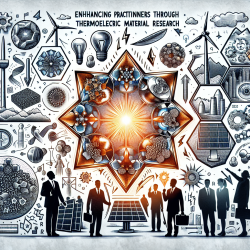The quest for alternative renewable energy resources has become increasingly urgent due to environmental concerns and the need to reduce fossil fuel reliance. Thermoelectric (TE) materials are pivotal in this endeavor as they convert waste heat into usable electricity. Recent research on chalcogenide crystals offers valuable insights for practitioners seeking to enhance their skills in this field.
The Significance of Chalcogenide Crystals
Chalcogenide crystals, containing elements such as sulfur, selenium, and tellurium, are known for their high electrical conductivity and low thermal conductivity. These properties make them ideal candidates for thermoelectric applications. The study conducted by Hasan et al. (2022) explores the thermoelectric transport properties of 30 chalcogenide crystals, providing a comprehensive database crucial for potential applications in renewable energy fields.
Key Findings from the Research
- The research reveals the transport properties of 11 chalcogenide crystals for the first time, including Tl2CdGeSe4, Tl2HgSiSe4, and AuAlTe2.
- The study utilizes first-principles calculations and semiclassical Boltzmann theory to compute essential parameters like the Seebeck coefficient and electrical conductivity.
- The findings indicate that doping chalcogenide crystals can significantly enhance their thermoelectric performance, with some doped crystals achieving a figure of merit (ZT) greater than 2.0.
Practical Implications for Practitioners
This research provides practitioners with a deeper understanding of the potential of chalcogenide crystals in thermoelectric applications. By leveraging these findings, practitioners can:
- Explore New Materials: Investigate the newly revealed properties of chalcogenide crystals to identify promising candidates for specific applications.
- Doping Strategies: Consider doping strategies that have been shown to enhance thermoelectric performance significantly.
- Thermoelectric Device Design: Apply insights from the research to design more efficient thermoelectric devices for energy conversion.
The Path Forward: Encouraging Further Research
This study serves as a foundation for further exploration in the field of thermoelectric materials. Practitioners are encouraged to delve deeper into the properties and potential applications of chalcogenide crystals. Future research could focus on reducing thermal conductivity values by exploring two-dimensional or one-dimensional material structures.
The ongoing development in this area promises to contribute significantly to sustainable energy solutions. By staying informed and engaged with such research, practitioners can play a crucial role in advancing renewable energy technologies.










